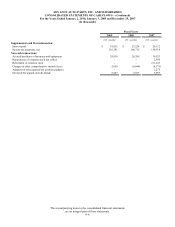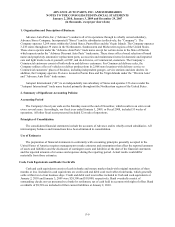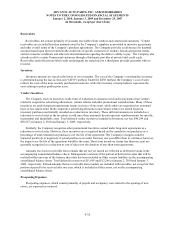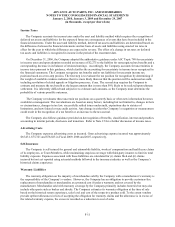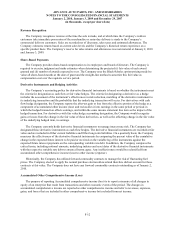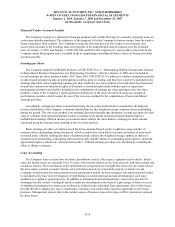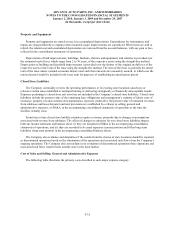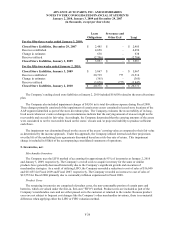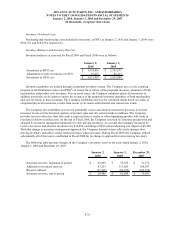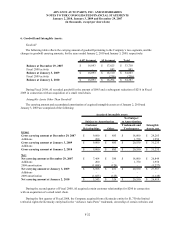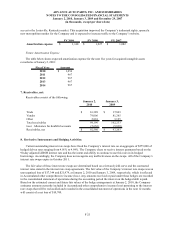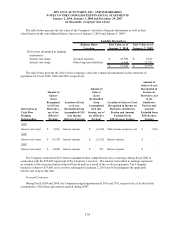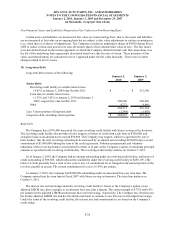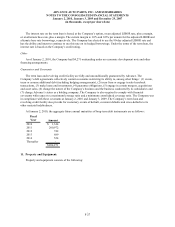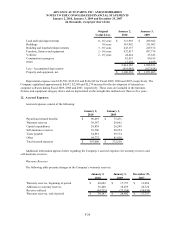Advance Auto Parts 2009 Annual Report Download - page 71
Download and view the complete annual report
Please find page 71 of the 2009 Advance Auto Parts annual report below. You can navigate through the pages in the report by either clicking on the pages listed below, or by using the keyword search tool below to find specific information within the annual report.ADVANCE AUTO PARTS, INC. AND SUBSIDIARIES
NOTES TO THE CONSOLIDATED FINANCIAL STATEMENTS
January 2, 2010, January 3, 2009 and December 29, 2007
(in thousands, except per share data)
.
F-18
15, 2008. The Company will consider this standard when evaluating potential future transactions to which it would
apply.
In December 2009, the FASB issued ASU No. 2009-16, “Transfers and Servicing (Topic 860) Accounting for
Transfers of Financial Assets,” which amends the ASC for the issuance of SFAS No. 166, “Accounting for
Transfers of Financial Assets – an amendment of FASB Statement No. 140.” The amendments in this ASU clarifies
the requirements for isolation and limitations on portions of financial assets that are eligible for sale accounting and
requires enhanced disclosures about the risks that a transferor continues to be exposed to because of its continuing
involvement in transferred financial assets. ASU 2009-16 is effective for the Company’s fiscal year beginning after
November 15, 2009. The Company does not expect the adoption to have a material impact on its consolidated
financial statements.
3. Change in Accounting Principle:
Effective January 4, 2009, the Company implemented a change in accounting principle for costs included in
inventory. Under the Company’s historical accounting policy, freight and other handling costs (collectively
“handling costs”) associated with moving merchandise inventories from our distribution centers to our retail stores
and handling costs associated with moving our merchandise inventories from our vendors to our distribution centers
were capitalized as inventory and expensed in cost of sales as inventory was sold. However, handling costs
associated with moving merchandise inventories from our HUB stores and PDQ®s to our retail stores after a
customer had special-ordered the merchandise were expensed as incurred in SG&A.
The change relates to capitalizing handling costs associated with moving merchandise inventories from our
HUB stores and PDQ®s to our retail stores, which are now treated as inventory product costs. Such costs are
includable in inventory and expensed in cost of sales as inventory is sold because they relate to the acquisition of
goods for resale by the Company. The Company has determined that it is preferable to capitalize such handling costs
into inventory because it better represents the costs incurred to prepare inventory for sale to the customer and it is
consistent with the Company’s treatment of other handling costs associated with moving merchandise inventories
from our distribution centers to our retail stores.
The change in accounting principle has been retrospectively applied to all prior periods presented herein related
to cost of sales and SG&A. However, because the inventory transferred is typically at the retail store for only one or
two days until customer pick-up, the current and historical impact of this change on the accompanying consolidated
balance sheets, consolidated net income, earnings per share, and consolidated statements of cash flows is not
material and, as a result, Inventories, net was not adjusted. Accordingly, there is no impact on any financial
statement line items other than cost of sales and SG&A, and there was no cumulative effect of the change in
accounting principle on retained earnings. The change in accounting principle was initially reported in the
Company’s Form 10-Q for the first quarter of Fiscal 2009. The table below represents the impact of the accounting
change on the current period presented and comparable periods presented, respectively:


